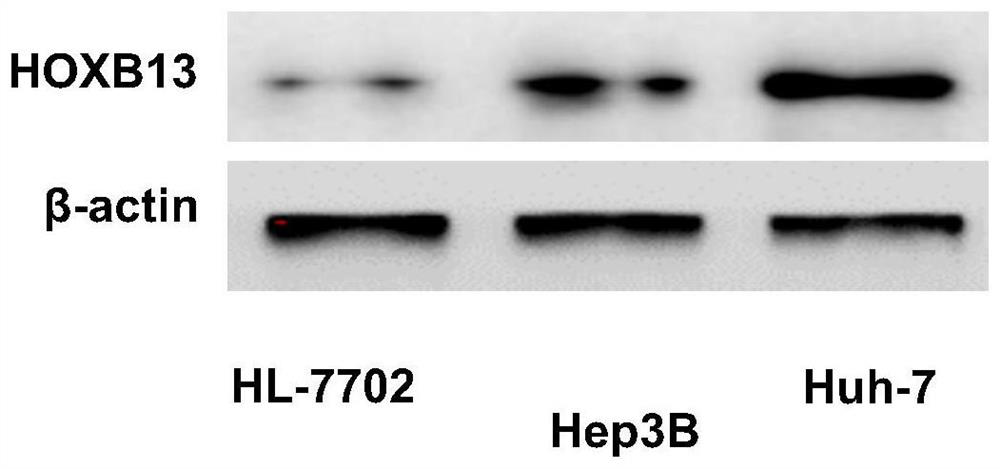Liver cancer tumor marker and application thereof
A tumor marker, liver cancer technology, applied to liver cancer tumor markers and their application fields, can solve the problems of lack of specific treatment methods, poor long-term prognosis of patients with hepatocellular carcinoma, and insidious onset, and improve the early diagnosis of liver cancer. The effect of horizontal, simple, fast and accurate detection
- Summary
- Abstract
- Description
- Claims
- Application Information
AI Technical Summary
Problems solved by technology
Method used
Image
Examples
Embodiment 1
[0032] This example illustrates the quantitative RT-PCR detection of the expression of the HOXB13 gene in liver cancer tissues.
[0033] 1. Tissue separation: The experimental tissue was derived from surgical patients with primary hepatocellular carcinoma. Once the surgically resected liver was isolated from the body, the lesion and surrounding paracancerous tissues 5 cm away were quickly excised and stored in liquid nitrogen (-80°C). The diagnosis of cancer and paracancer is based on pathological diagnosis.
[0034] 2. Extraction of ribonucleic acid (RNA): total RNA was extracted with a Trizol kit (Invitrogen), and the extraction method was referred to the instructions of the Trizol kit. When RNA is ready to be used, the RNA can be precipitated using the following method: add NaAc to 0.3M, centrifuge at 12,000×g for 5 minutes.
[0035] 3. Synthesis of cDNA:
[0036] (1) Add 4 μL of template RNA (0.5 μg / μL), 2 μL of 20 pmol / μL random primer, 5 μL of deionized water into the...
Embodiment 2
[0050] This example illustrates the use of quantitative RT-PCR to detect the expression of the HOXB13 gene in the overexpressed liver cancer cell line Hep3B.
[0051] Hepatocellular carcinoma Hep3B, Huh-7 cell lines and HL-7702 normal liver cell lines were selected, and after cell culture, WB expression was qualitatively and quantitatively performed. Wherein said cell line comes from Shanghai Cell Bank of Chinese Academy of Sciences.
[0052] According to the method in Example 1, RNA was extracted from different liver cancer cell lines, and cDNA was synthesized by reverse transcription. Using GAPDH as an internal control, and using the synthesized cDNA of different liver cancer cell lines as a template, the PCR reaction was carried out according to the method described in Example 1, and the agarose was gelled. PCR amplification products were detected by gel electrophoresis, the results are shown in figure 2 .
[0053] Depend on figure 2 It can be seen that HOXB13 gene pro...
Embodiment 3
[0055] The siRNA targeting HOXB13 was constructed, the specific sequence is shown in Table 2, and the liver cancer cell line was knocked down, and an empty vector (vector) was set as a negative control.
[0056] Table 2 HOXB13 siRNA sequences
[0057]
[0058] Two kinds of HOXB13 siRNA, negative control (NC) siRNA, empty lentiviral expression vector (Lenti-con), and HOXB13-expressing lentiviral expression plasmid (Lenti-HOXB3) were pressed into the transfection reagent using liposome (Lipofectamine 2000) respectively. Concentration of 50nmol / L was transfected into Huh-7 cells and Hep3B cells respectively, and cultured with DMEM containing 10% fetal bovine serum. According to the method described in Example 1, RNA was extracted from different liver cancer cell lines, and cDNA was synthesized by reverse transcription. Using GAPDH as an internal control, and using the synthesized cDNA of different liver cancer cell lines as a template, quantitative RT-PCR experiments were carr...
PUM
 Login to View More
Login to View More Abstract
Description
Claims
Application Information
 Login to View More
Login to View More - R&D
- Intellectual Property
- Life Sciences
- Materials
- Tech Scout
- Unparalleled Data Quality
- Higher Quality Content
- 60% Fewer Hallucinations
Browse by: Latest US Patents, China's latest patents, Technical Efficacy Thesaurus, Application Domain, Technology Topic, Popular Technical Reports.
© 2025 PatSnap. All rights reserved.Legal|Privacy policy|Modern Slavery Act Transparency Statement|Sitemap|About US| Contact US: help@patsnap.com



